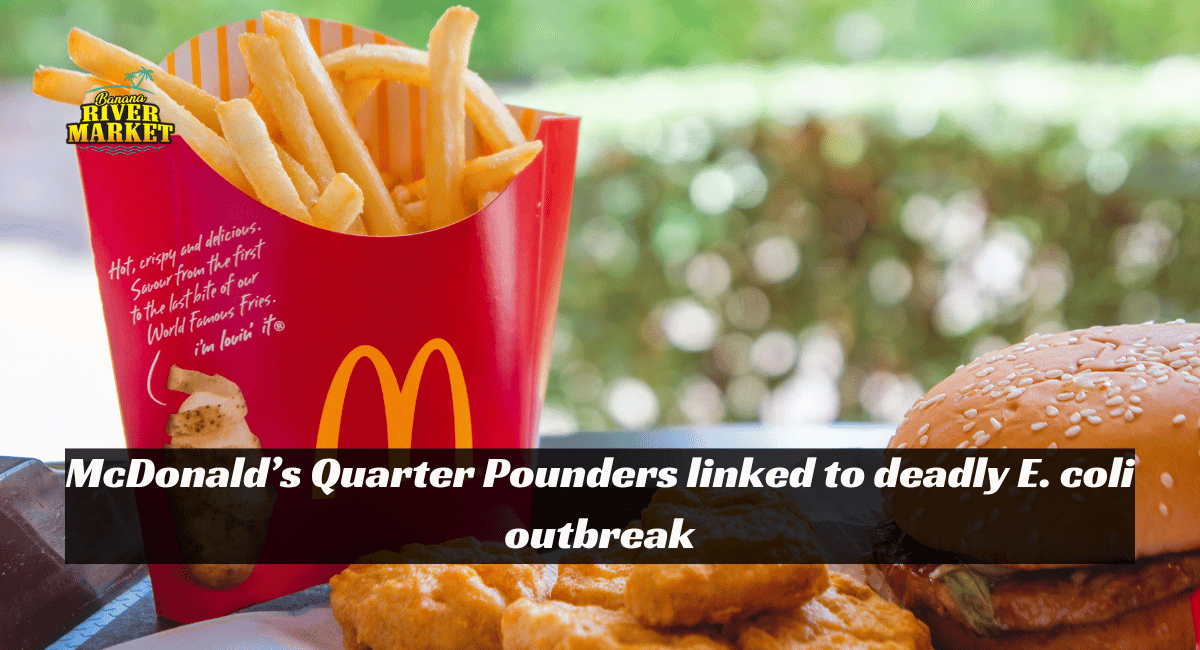The Centers for Disease Control and Prevention (CDC) recently warned about an E. coli outbreak linked to McDonald’s Quarter Pounders sold across the United States.
The outbreak, which has already caused one death and sent ten people to the hospital, has affected at least 49 people in multiple states. While the exact source of contamination is still under investigation, McDonald’s McDonald’s has taken proactive steps by halting certain ingredients in some states.
States Affected by the Outbreak
According to the CDC, most cases have been reported in Nebraska (9 cases) and Colorado (27 cases). However, the outbreak has also been identified in eight other states, raising concerns that the contamination might be more widespread than initially thought.
Tragically, one person from Colorado, an older resident, has died due to the Infection.
What Ingredient is Contaminated?
Neither the CDC nor McDonald’s has pinpointed the specific ingredient responsible for the E. coli outbreak. However, McDonald’s has stopped using fresh slivered onions and quarter-pound beef patties in several states as a precautionary measure.
These two ingredients are under suspicion, as they are used exclusively in McDonald’s Quarter Pounders. Investigators are working diligently to determine if either of these ingredients is the cause of the contamination.
The CDC has emphasized that McDonald’sMcDonald’s decisionMcDonald’sdecisionMcDonald’s decision to pause the use of these ingredients is a proactive move while the investigation is ongoing. The goal is to minimize further risk to customers while the source of the contamination is being identified.
How Dangerous is E. coli?
E. coli is a type of bacteria that can cause severe foodborne illness. When ingested, it can lead to a range of symptoms, including:
- Severe stomach cramps
- Bloody diarrhea
- Vomiting
In more severe cases, E. coli infections can cause serious complications. Some people may develop hemolytic uremic syndrome (HUS), a condition that can lead to kidney failure. The CDC has confirmed that one child involved in this outbreak is currently being treated for this kidney disorder caused by the E. coli infection.
Symptoms of E. coli Infection
Typically, symptoms of E. coli infection start to appear about three to four days after consuming contaminated food. While some individuals may experience mild symptoms and recover within a week without needing medical treatment, others may suffer from more severe symptoms, such as:
- High fever
- Severe dehydration
- Inability to keep liquids down
- Dizziness
These more severe symptoms often require medical intervention, especially in vulnerable populations such as children, older people, and people with weakened immune systems. If left untreated, E. coli infections can potentially be life-threatening.
McDonald’sMcDonald’s Takes Action
In response to the CDC’s food safety alert, McDonald’s McDonald’s has temporarily removed Quarter-Pounders from the menu in several states while the investigation is underway. This decision is intended to prevent further exposure to the contaminated ingredients and ensure safety.
McDonald’s McDonald’s is also cooperating fully with health officials to determine whether the contaminated ingredients have been distributed to other restaurants or businesses.
Although the slivered onions and quarter-pound beef patties are primarily used for McDonald’s Quarter Pounders, officials are investigating whether these ingredients might be part of or used in products elsewhere.
How E. coli Spreads
E. coli bacteria can spread through contaminated food or water. Familiar sources of E. coli contamination include:
- Undercooked ground beef
- Raw vegetables
- Unpasteurized milk
- Contaminated water
In many cases, E. coli is introduced into the food supply through improper handling or storage of food. Once consumed, the bacteria can cause an infection in the digestive system, leading to the symptoms mentioned above.
Precautions You Can Take
While McDonald’s is taking steps to address the current outbreak, there are actions you can take to protect yourself from E. coli infections:
1. Cook MeatMeat Thoroughly: Ensure ground beef is cooked to an internal temperature of at least 160°F (71°C) to kill harmful bacteria.
2. Wash Produce Carefully: Rinse fruits and vegetables under running water, especially if you plan to eat them raw.
3. Avoid Cross-Contamination: Keep raw MeatMeat separate from other foods when cooking. Use separate cutting boards and utensils for raw MeatMeat and other ingredients.
4. Practice Good Hygiene: Wash your hands thoroughly with soap and water after handling raw MeatMeat, using the bathroom, or touching animals.
What to Do if You Feel Sick
If you believe you may have consumed contaminated food and are experiencing symptoms of E. coli infection, seeking medical attention is essential. Early diagnosis and treatment can help prevent more severe complications.
Additionally, the CDC advises anyone who suspects they might be part of this outbreak to inform their healthcare provider and to keep track of symptoms. Health professionals may be able to test for E. coli through a stool sample, which can confirm if you are infected with the bacteria.
Current Status of the Investigation
The CDC’s investigation is ongoing, and health officials are working around the clock to trace the source of the contamination. Both the CDC and McDonald’s McDonald’s are committed to ensuring that all necessary steps are taken to protect the public and prevent further cases of E. coli infection.
While the exact cause remains unidentified, McDonald’s McDonald’s customers are encouraged to stay informed by following updates from both the CDC and McDonald’s McDonald’s regarding the safety of the affected products.
Conclusion:
The E. coli outbreak linked to McDonald’s Quarter Pounders is a severe public health concern that has already caused significant illness and one tragic death. With the CDC and McDonald’s McDonald’s working to determine the exact source of contamination, the company has taken immediate action by halting the use of specific ingredients to prevent further cases.
Customers should remain cautious and stay updated on the investigation’s progress to ensure safety.
READ MORE: Popeyes’ Well-Known Thanksgiving Turkey Is Back, and Here’s How to Get Yours

